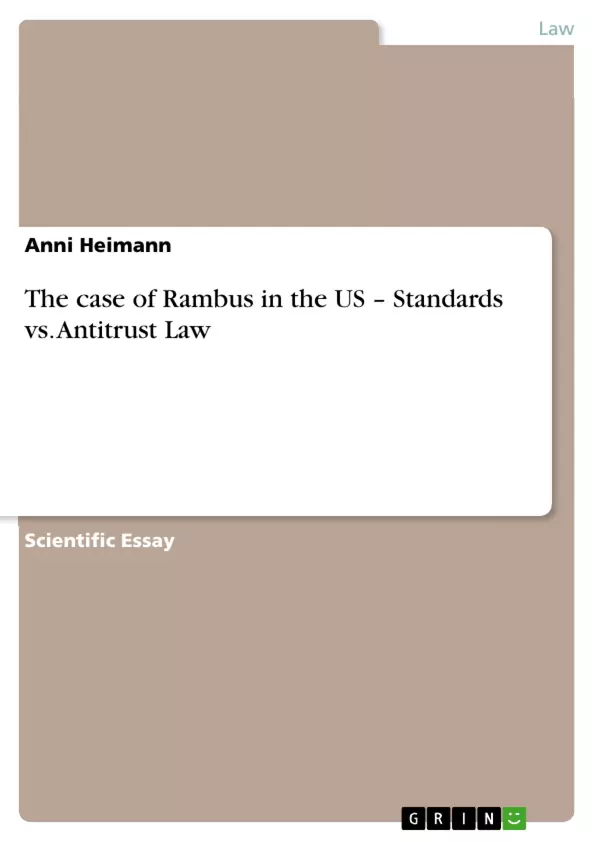Global competition is particularly fierce in the IT and communication industry. For this reason the competitive landscape is changing permanently and innovation is a key competitive driver, especially in the software industry. The objectives of patent law however, run contrary to the objectives of antitrust legislation, which have the goal to foster competition and to protect market actors and to avoid damnifications. Additionally a permanent contradiction between privately funded research and collective standards exists.
Inhaltsverzeichnis (Table of Contents)
- Introduction
- Abstract
- Legal foundation Sherman Act/FTC Act
- The Sherman Act
- The FTC Act
- Patent registration under US law
- Terminology
- Legal Standards
- JEDEC
- The Rambus case in the USA
- Parties Involved
- Federal Trade Commission
- Rambus Inc
- The Facts
- Indictment
- The monopolization of certain Technology Markets
- Patent Ambush
- Amendment
- Destruction of Evidence
- The judgment of the Federal Trade Commission
- Foreseeable Consequences
- Rambus judgment to be applied to Europe?
- Market Demarcation
- Possible Judgment according to European Antitrust Laws
- Final Remark
Zielsetzung und Themenschwerpunkte (Objectives and Key Themes)
This work examines the complex relationship between intellectual property rights and antitrust law, focusing on the Rambus case in the United States. It aims to analyze the legal implications of this case, exploring the conflicting objectives of patent protection and competition promotion. The text investigates how the Rambus case exemplifies the potential for companies to manipulate standardization processes for unfair competitive advantage. Key themes discussed in the text include:- The tension between patent law and antitrust law
- The role of standardization in the IT and communication industry
- The potential for "submarine patents" to undermine fair competition
- The legal foundations of antitrust law in the United States
- The relevance of the Rambus case to European antitrust law
Zusammenfassung der Kapitel (Chapter Summaries)
- Introduction: This chapter introduces the case of Rambus and its context within the highly competitive IT and communication industry. It highlights the tension between patent law's objective to protect innovation and antitrust law's focus on fostering competition. The chapter also discusses the use of patents as a tool for companies to gain unfair competitive advantages through manipulation of standardization processes.
- Terminology: This chapter provides definitions of key terms such as legal standards and the JEDEC standard, which is relevant to the Rambus case. It helps clarify the specific terminology used throughout the text.
- The Rambus case in the USA: This chapter details the Rambus case, outlining the parties involved (including Rambus Inc. and the Federal Trade Commission), the facts of the case, and the indictment against Rambus. The chapter explores the accusations of monopolization, patent ambush, and destruction of evidence.
- Rambus judgment to be applied to Europe?: This chapter examines the potential application of the Rambus judgment to European antitrust laws. It focuses on the concept of market demarcation and how the European Union might handle similar cases involving intellectual property rights and competition.
Schlüsselwörter (Keywords)
This text focuses on the interplay between intellectual property rights and antitrust law in the context of the Rambus case. Key concepts include patent protection, antitrust legislation, standardization processes, "submarine patents," and market manipulation. The text also examines the legal foundations of antitrust law in the United States, including the Sherman Act and the FTC Act, as well as the potential application of the Rambus judgment to European antitrust law.
Excerpt out of 26 pages
- scroll top
- Quote paper
- Diplom-Wirtschaftsjuristin (FH) Anni Heimann (Author), 2007, The case of Rambus in the US – Standards vs. Antitrust Law, Munich, GRIN Verlag, https://www.grin.com/document/133185
Look inside the ebook



